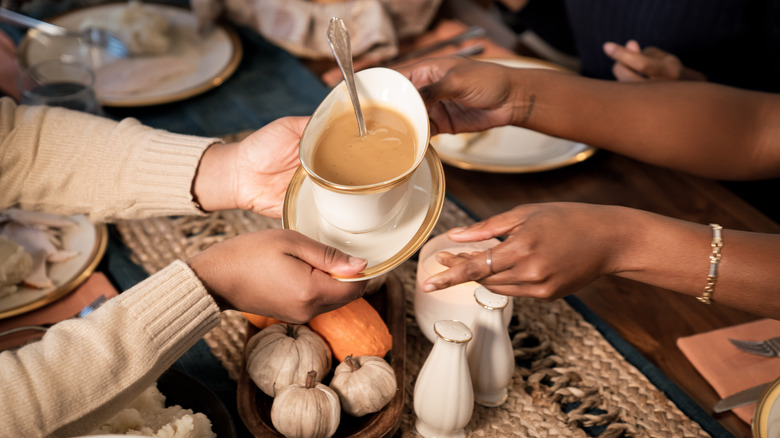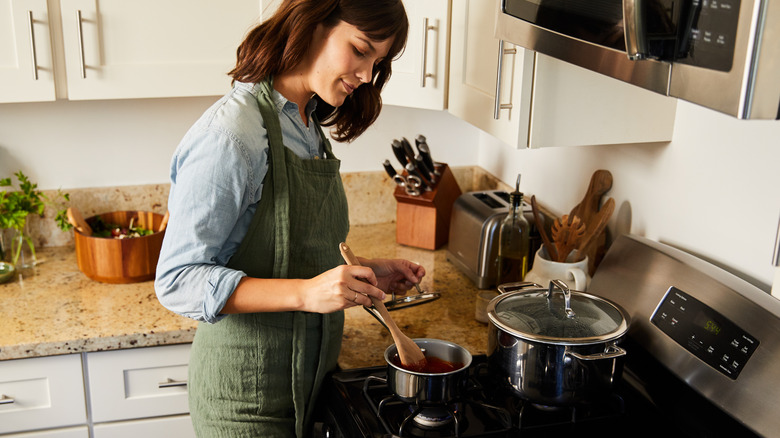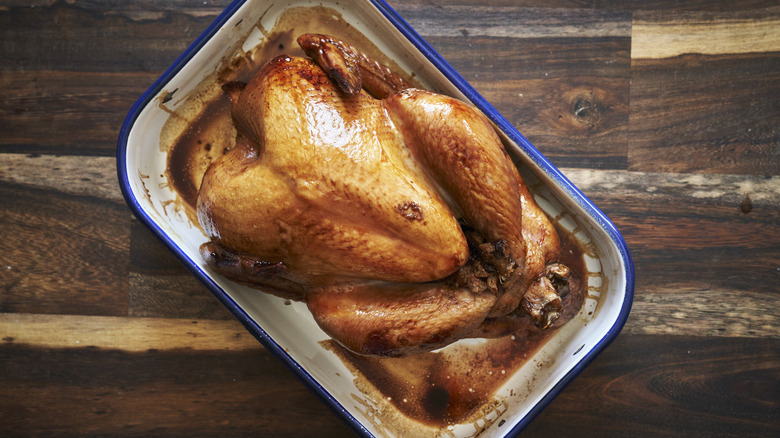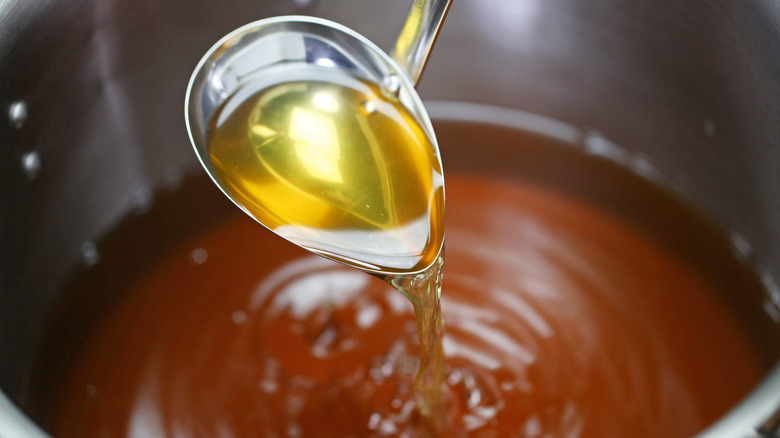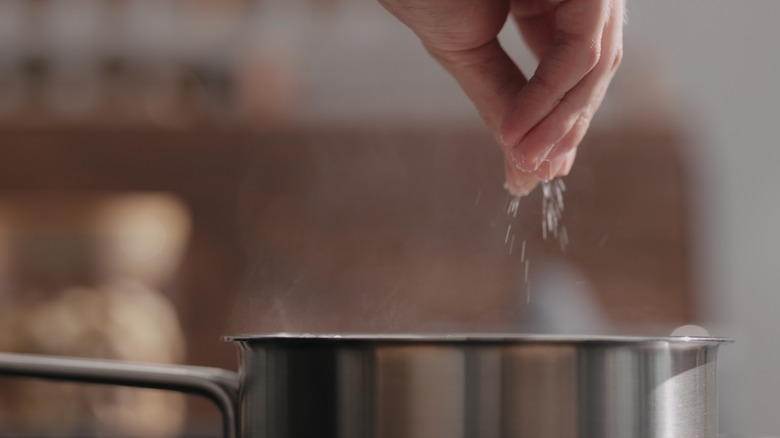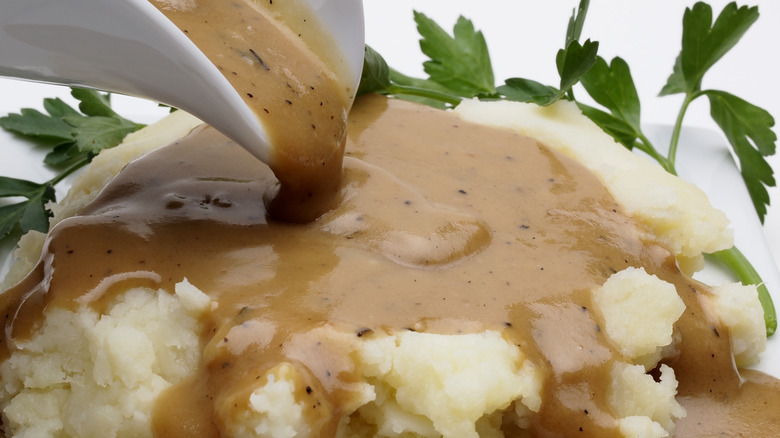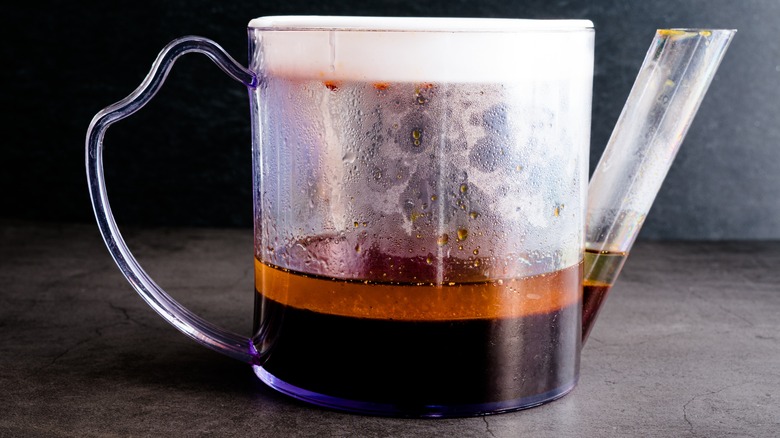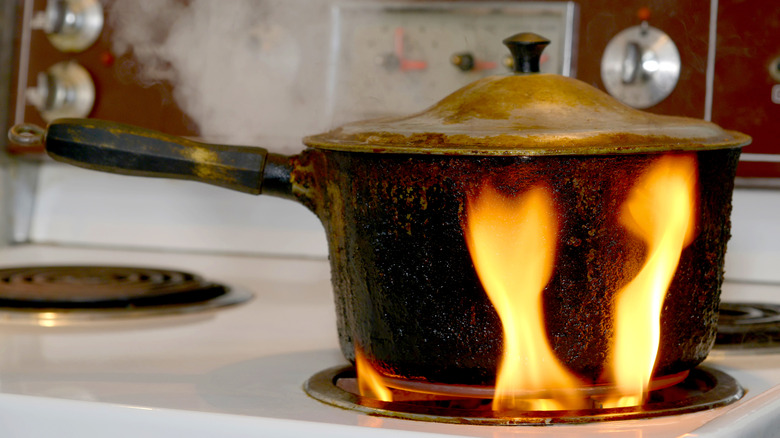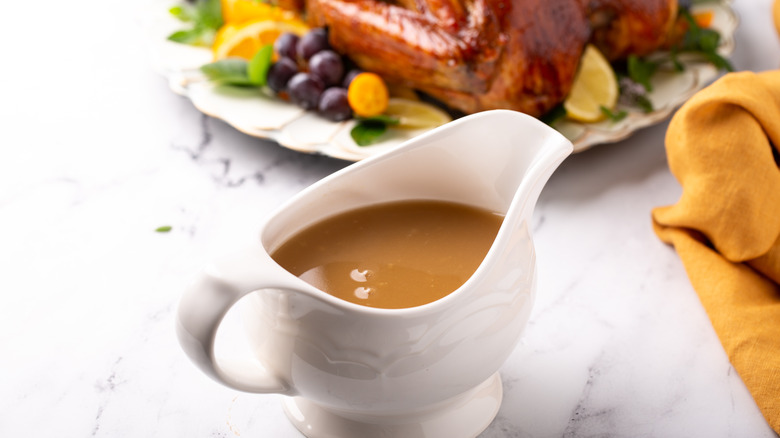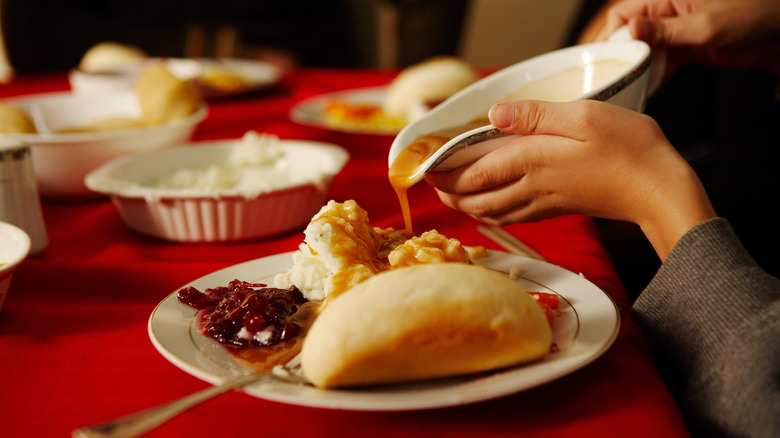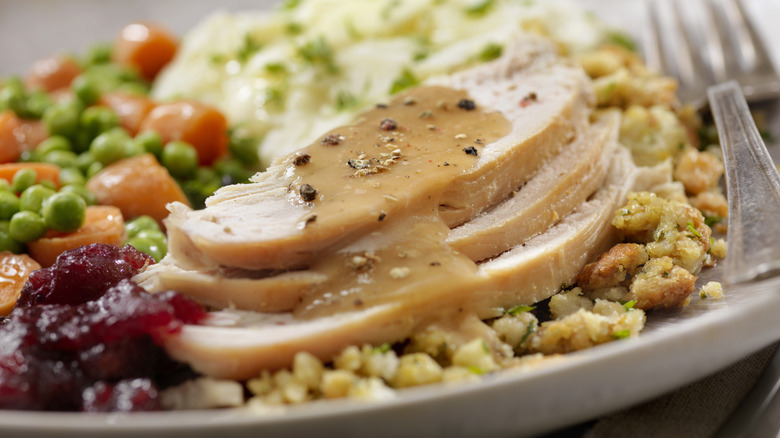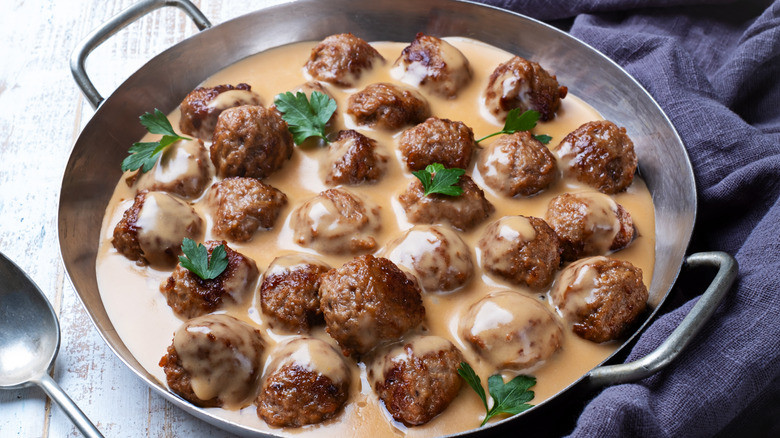Mistakes Everyone Makes When Cooking Gravy
We've got 99 problems, and gravy is all of them! But no matter how much salt you accidentally poured into the mix, or how thick that greasy skin is on top, we've got a solution for every frustrating issue under the sun. Yes, even if your gravy is lumpier than a pair of messed-up lip implants on "Botched," we got you.
Gravy goes with all things Thanksgiving. But since it slides into home plate just before the start of the meal, it's also easy to screw up. While some might enjoy the subsequent spotlight foisted upon them, as hangry eyes around the dinner table appear to wonder what's the freakin' hold-up, most of us would rather melt into the gravy boat than disappoint our guests.
From the ridiculously runny, to the charred and flavorless, we're throwing out a life preserver to kick off the most stressful meal of the year. You don't even need a turkey! Work up that appetite, cuz killer gravy, here we come!
You made something, but it ain't gravy
To the naked eye, brown stuff in a little turkey-shaped saucière is gravy. Except if you forgot either the fats, the starch, or the roux ... you didn't make gravy. You made a brown sauce. Or maybe a type of broth. Neither of which will be written about in your dinner guests' diaries.
You can't make gravy without a fat that's packed with flavor. And this time of year, that's the turkey drippings. Even meat-free gravy recipes usually call for butter, or a chicken-like base. This is where you begin building that savory profile that complements literally everything on your plate.
Then there's the starch, which is usually cornstarch or flour. But in order to incorporate it into your base, it will need to be made into a paste, or roux. Using a 1:1 ratio, warm up a little of the fat until it's melted. Add the flour and whisk for roughly five minutes, until the flour is cooked. (An easy trick for checking doneness is to sniff it. If it no longer smells like flour, it's ready to rock, and it won't make your gravy taste like bread dough.) Once the flour is cooked, you can add it to your gravy pan.
Ya got zero turkey drippings up in there
But we're not roasting a turkey! How can we make gravy? Even if you're outsourcing the bird this year — or going for a fried or grilled turkey — you don't have to miss out on beautiful homemade gravy. You can still whip up a batch that tastes just as succulent as the O.G., starting by roasting a different type of poultry: wings. (Is it possible that Thanksgiving just got even awesomer?)
Gravy is all about those luscious pan drippings, but you can use any kind of bird you like. Chicken wings offer a traditional poultry flavor akin to its turkey cousin. And the process is as simple as popping salt-and-peppered wings into the oven for a summer vacation in a roasting pan.
After the wings brown, and you can see bubbly juices simmering around the edges, remove everything from the pan, including the juices, but leave those crusty, caramelized bits. Those are your glorious flavor bombs, which you can release from the metal by deglazing the pan with a little bit of stock and some heat. Once the liquid boils, you've got wing drippings to make your gravy. And don't forget the chicken wings themselves! With a little dipping sauce, they just might satisfy even the most notorious fried turkey skin thief.
It's runnier than the Boston marathon
Your gravy is richly colored, expertly seasoned, and ... as liquified as melted ice cream on a hot sunny day. So is this the year you try to make gravy soup a thing? (Ew. Please no.) Instead, grab a little cornstarch or flour and get to work.
Wait! Don't just dump the dry ingredients straight into the gravy boat. This method goes back to once again properly introducing the starches to the liquids. (Hi, cornstarch, meet gravy — you guys have fun chatting, mkay? Be right back.) Except instead of a classic roux, we're living fast and free with a slurry.
Start with up to 2 tablespoons of cornstarch (arrowroot also gets a thumbs up!), and stir it in a separate bowl with a little bit of the liquid gravy. Mix until it forms a smooth paste (no lumps!), then gently whisk it into the rest of your gravy, while simmering the entire mixture. If it still needs additional thickening, go ahead and slurry some more. Accept it. You're now a professional slurrier.
Holy Himalayas, there's too much (cough) salt
We've all over-salted a dish at some point. But while you can usually salvage a meal by serving it over rice, or mixing it into a hotel buffet's worth of scrambled eggs, it's generally considered unappetizing to add eggs of any kind to gravy. So what can you do if you accidentally added too much salt? Add unsalted things!
Here, you want to go for zero-salt liquids like water, plain broth, unseasoned stock, or even heavy cream. The key is to add elements that don't impart even more seasoning and sodium into the mix. Otherwise, you'll undo your efforts no matter how much liquid you add, and then end up with several gallons of gravy that's still too salty.
Since we're starting our gravy with a base of turkey drippings — which are already packed with flavor, just like the bird you roasted — mix your gravy completely before tasting and adding any more seasoning. Chances are, your drippings were fire, your deglazing broth was bomb, and you might not even need any extra salt at all!
It's a little lumpy (like, a lot lumpy)
We accept slightly lumpy smashed potatoes (because the lumps are potatoes, which are delicious). But the gravy train should be a completely smooth ride from start to finish. Still, even if you're about to serve dinner — if your eye catches some goopy glops — you can save the day with a quick fix. Grab your blender.
A countertop blender, food processor, or immersion blender does this job in a jiffy. Just pour your gravy into the basin, and basically blend the living daylights out of it. Lumps, gone! If you're using an immersion blender, just move your gravy pot off the heat, then submerge the machine and blend.
To prevent future fumbles, work your way to Smooooth City by passing on the wooden spoon or fork. Whisking your gravy mixture frequently, until it thickens, guarantees you'll have no freaky lumps, plus a silky, velvety finish.
Your gravy tastes like nothing-sauce
Your gravy could be smooth as caramel, and glistening like a glassy lake at dawn, but it's also gotta taste as gorgeous as it looks. And if it's all style over substance, nobody wins. Not even the green beans, all draped inside the casserole dish and lookin' thirsty for an upgrade. Got a flavorless gravy situation? All you need is a little boost.
If it's just a matter of accentuating the depth of the flavors you already have, you can try adding a little salt (a little, people!) and fresh ground pepper. A pinch of extra seasoning just might be all it takes, dearest Salt Bae.
But if the entire flavor profile is feeling a bit watery or one-note, a rich seasoning agent can be clutch at the last minute. Martha Stewart recommends incorporating a scoop of D'Artagnan brand duck & veal demi-glace. It's basically a slow-cooked, highly condensed stock that really packs a punch. Soy sauce also works if you want more of a mysterious and intriguing umami vibe. But whichever path you choose, take it slow, and taste as you go. This is your new gravy life. Now go live it!
It's got a (hurl) greasy skin
(We're gonna try to get through this one without dry heaving.) You know the layer that forms on top of the gravy after it's had a chance to rest peacefully for a minute? The greasy, thick, kind of gelatinous ... okay, you get it. That stuff. That's not really part of good gravy. That's extra fat. And while we love a little fat for flavor, that gloopy fat's gotta go. But there's an easy fix for this, um, particular circumstance.
Step 1 in the fight against greasy skin is to separate the fat from your turkey drippings before you make the gravy. You want all the flavorful broth, and none of the fat. You can do this with a fat separator, or even just by letting the juices sit in a pitcher, and then skimming off the fat once it rises to the top.
Step 2 is for everyone who forgot to do Step 1. (Hey, it's Thanksgiving, and you've got a lot on your mind, we understand.) This one's easy: Make the gravy, realize it's developing a gross, greasy skin, and then skim off the skin! The winning strategy is to leave a little extra time in your dinner prep to let your gravy actually cool down completely. That's when you remove the oily fat that rose to the top. Just reheat before dinner, and voila! No one has to think about this topic ever again.
Ew, it tastes burnt
We always search high and low for fixes, hacks, and worst-case scenario saves. But if your gravy tastes like the still-burning embers of a campfire ... it's too late. And as much as we hate to say it, this is a case for a total gravy redo. RIP blackened turkey gravy.
Redditors have suggested that a little peanut butter can salvage a charred sauce. But true Thanksgiving survivalists know to put aside some turkey bits for this bummer scenario. Saving the extras — like the heart, liver, and neck (" ... with some fava beans and a nice chianti" look, if you know you know) — could really come in handy should things go south.
Burned gravy begins when turkey drippings cook beyond the point of caramelization, and instead burn in the pan. Those ashy bits then flavor the entire batch of gravy with the bitter, metallic taste of pure sadness. If you see that the drippings look black when you pull the turkey out, immediately throw those extra giblets you saved into a pan on the stove. Then, sauté them with chopped celery, onion and carrots until you have new turkey drippings to work with. From there, continue onto gravy heaven.
You left it out in the cold
In case you were wondering, gravy loves a warm little container, lots of active pouring, and zero alone time sitting around getting cold. Because that's when it transforms from a beautiful silken butterfly into a congealed non-pourable creature. Like Gizmo from "Gremlins" if he eats after midnight. (So that movie was just about nighttime indigestion?)
Even though gravy may be the last dish to finish on Thanksgiving day, it's likely that there won't be much room on the stove to keep it warm. Luckily, you don't have to serve cold gravy anymore. There are plenty of options to keep it comfy and cozy for hours.
Got an insulated thermos? Pour your hot gravy into it, screw on the top, and you'll have perfectly warm gravy when you're ready for it. You could also go full "Iron Chef America" with an immersion circulator, or a hot water bath in a Crock Pot, but Thanksgiving is stressful enough — even without a complicated gravy station. How about a good old gravy warmer that gets its heat from a candle, or a minimalist 2-quart electric hot pot? You can even swap out your vacuum sealed thermos for a table-ready double-walled, stainless steel sauce server to keep your gravy heated in style.
You used whatever ingredients
As with any family gathering, there's always the chance that you might be throwing dishes together last-minute in someone else's kitchen. If that's the case, be extra vigilant about what ingredients you're adding to your recipe. Even though it may have been an accident, a nasty component in your gravy will send the whole batch into the trash, with no remedy in sight.
Slate staffer Jeff Bloomer recalled whipping up his signature vegetarian-friendly mushroom-thyme gravy for a Thanksgiving dinner. But after incorporating the soy sauce, dried porcini mushrooms, and heavy whipping cream, something didn't taste right. "I could not for the life of me figure out what I did. Then I looked closer at the 'light cream,'" he recalled. "I had actually used my in-laws' truly foul fake vanilla creamer. RIP to that gravy, which went directly down the drain but will unfortunately be remembered forever."
You snubbed the gravy aisle
Of course, the dream is to flawlessly execute a fully home cooked Thanksgiving meal for 20 people without breaking a sweat. But the reality is probably a little different. Does anyone have time for three days of cooking? Are there grandmas available to hire for these purposes? Listen — you don't have to be a hero. You can proudly hit up the gravy aisle for a store-bought brand that tastes like no one will know. (Also, some of them are so savory and delicious, you might even convince yourself you made it.)
Prepared gravy comes in all kinds of versions: bottles, dehydrated packets, cubes — a style for every harried cook. But the most-loved varieties feature a deep color and rich flavor that comes together in a fraction of the time that homemade gravy does.
A consistent front-runner is Knorr Roasted Turkey Gravy Mix. All you need to do is add water, bring the mix to a boil, then simmer for a few minutes until it thickens. A splash of wine or fresh herbs makes this golden gravy seem like it took hours to make. On the flip side, you can snag a pouch of McCormick Turkey Gravy Mix if you want to bump up the volume of your homemade batch. This mix provides a wonderful base for your pan drippings, and guarantees you won't be running out of everyone's favorite condiment on turkey day.
It died in the fridge
You basically donated your body to culinary science for that gorgeous Thanksgiving meal, so of course you want to save every last leftover! But if you don't keep an eye on the gravy that got bumped to the back of the fridge, it could go bad before you realize it. To prevent this, all you need is a little knowledge, and maybe a label-maker. (Okay, you could just write the date on a piece of tape, but would that be as fun?)
As of 2023, the USDA gravy rules go like this: Fridge storage is good for up to three or four days. And if you're freezing it, you've got a safe window of about four to six months.
So let's say it's day four in the fridge, and you're wondering ... hmm, has this gravy been naughty or nice? Well, thankfully, there are plenty of signs that your gravy's gone to the dark side. Is it wearing a moldy sweater? Has it developed a slimy slick? Is it gray, when it once was brown? If it looks or smells different than it did when you first popped it in the fridge, don't risk it. Throw it out.
You didn't go for the razzle-dazzle
If this is yet another year of making the gravy just for the sake of having gravy on the table, maybe it's time to step out of your saucy brown comfort zone. Don't be afraid to bring the razzle-dazzle to the gravy boat! (It's commonly assumed that people get sleepy after eating because of the tryptophan in the turkey, or the heaviness of the food. But according to our unofficial scientific studies, it's the snoozer gravy that bored them to sleep.)
Add roasted garlic and fresh herbs for an easy upgrade that packs a whole lot of memorable flavor. Just chop the vegetables and mix them into your silky gravy base. Here, everyone will be hunting down the "lumps" of zesty garlic.
If you're ready to go to the next level, you can amp up the flavor even more with browned butter, brandy, mushrooms, bacon, or even truffles. Almost anything goes. For the record, this method works with homemade gravy, as well as store-bought varieties. Of course, don't forget to taste as you go.
You skipped the best part: Leftovers
Basic turkey sandwiches are for amateurs. Don't miss out on the best part of Thanksgiving by phoning it in with your leftover gravy! Try something new and create a tradition you'll look forward to every year. At midnight. Alone. Illuminated by the blinding light of the fridge. Heck yeah!
All it takes is a little thinking outside of the box, in order to experience an uncharted world of flavors — brought to you by the most sacred of holiday recipes. No, it's still not canned cranberry sauce. (Ocean Spray, why do we love you so much!)
Tap that leftover gravy for everything from saucing up baked meatballs (like the Swedish ones at IKEA), to thickening a pot of soup, topping a plate of egg noodles, and rebooting your gravy with fries. Pour it over a patty melt, use it as a dipping sauce for fried chicken, or elevate an eggs Benedict with those savory spices. Use your imagination and live your best life. It's all gravy from here!

